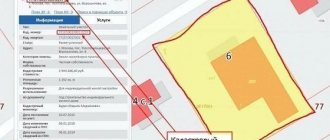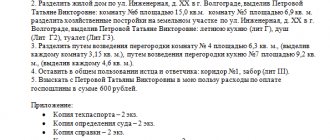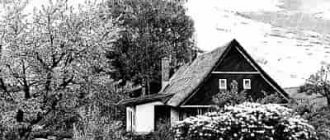Home / Housing disputes / Privatization of land under an apartment building
The privatization of land plots has a specific purpose - to allow citizens to register the land as their own. The re-registration of land plots next to a private house is more or less clear. It’s another matter if you need to privatize the land under an apartment building. Many people do not understand why it is necessary to privatize land at all if they already live in a separate apartment, and the yard is just an addition to the house?
It is worth noting that a privatized site under an apartment building differs from a non-privatized one. For example, if the administration wants to build an entertainment center or office near the house, it will carry it out without hindrance. But if the land is privatized by the residents of the house, then development will take place only with their consent. These are two big differences that point in favor of the privatization of the local area.
How to implement it in practice, where to start and are documents needed for the residential building itself? Let's figure it out.
Is it possible to privatize the land under an apartment building?
Legislative regulation of the procedure is reflected in the Housing Code. The territory next to the house belongs to the property of an apartment building (Article 36 of the Housing Code of the Russian Federation). Consequently, the residents of the house have every right to privatize the adjacent area and become its shared owners , if they are no longer such after the house is put into operation.
According to the Decree of the Government of the Russian Federation No. 491 of August 13, 2006 (as amended in September 2021), the standard area of a house includes:
- land under an apartment building;
- landscaped areas and territories near the building;
- parking lots;
- technical service points;
- places for drying clothes, etc.
After the privatization of these areas, apartment residents will be able to dispose of them according to the right of shared ownership. Usually in such cases, property management is entrusted to the HOA or Management Companies.
But you need to understand that the land under an apartment building must have strict boundaries and comply with the Urban Development Plan. The registered land plot always has a cadastral passport: boundaries, area, intended purpose, distinctive features and other parameters. If there is no cadastral plan, the specified characteristics are displayed in the technical plan for a residential building in a similar way.
Features of legal regulation of common property of a residential building
Before we begin to analyze the question of whether it is possible to privatize land plots for apartment buildings, we should understand the definitions that will be used repeatedly below.
An apartment building (hereinafter also referred to as “MKD”) is a building intended for people to live in; it must have at least two apartments, and the apartments must have separate exits to common areas (for example, entrances) or to a local area.
If a house does not have the above characteristics, then it is not an apartment building.
In a private house for one owner, when the latter is the person who owns everything himself and is responsible for the entire house himself, then the MKD has a completely different legal status. This is due to the fact that apartment buildings have apartments that are owned by individuals, and there is common property that belongs “to everyone at once,” and which is used by everyone living in such a house.
Such property includes:
- All rooms that are not integral parts of the apartment area (staircases, attics and basements and all other similar ones).
- The roof and all its technological elements (pipes, hoods, rafters, slate, etc.).
- Load-bearing structures (these are walls and ceilings, without which the house will simply fall apart).
- General-purpose enclosing structures (doors in the entrance, for example), other common property used by all residents (railings, porch, etc.).
- Electrical equipment that is necessary for general maintenance of the house (wiring to apartments, distribution panels, elevators with all mechanisms, etc.);
- Measuring common house devices for accounting of utility resources entering the house;
- Land plot (hereinafter referred to as “ZU”).
That is, there are two facets of property available in apartment buildings - personal (apartments and everything in them, including wiring and water pipes) and general (as described above).
The land plot, among other things, also refers to the common property of the house. Such property has a special legal status - it belongs to all apartment owners at once and is not divided into separate pieces for each.
This is directly stated in Articles 36 of the Housing Code of the Russian Federation and 16 of the Federal Law “On the Entry into Action of the Housing Code of the Russian Federation” (hereinafter also referred to as the Law on the Introduction of the Housing Code of the Russian Federation). These rules of law imperatively establish that the land plot on which the house stands belongs to all owners of apartment building premises on the right of common shared ownership. Only this way and no other way
. No reservations.
What do these standards mean for residents? According to them, such a plot is single and indivisible. It is a mistake to assume that the privatization of land plots under MKD will make any of the apartment owners the rightful owner of some piece of land under the windows of the house, on which he can do whatever his heart desires
.
This is absolutely not true
. Privatization, in relation to this particular case, is a process that will result in the emergence of common ownership rights for all owners of the premises.
All land under the houses is the exclusively common property of all owners of the premises of the house. They are united and indivisible, and it is impossible to single out a certain part of them that would belong to its individual residents. The law does not establish such exceptions.
It would seem that everything is simple, but what is a land plot from the point of view of the law? This is the area where the house itself is located, as well as its landscaping elements (benches, clothes dryers, children's carousel, parking space for vehicles and other objects created for the needs of the residents of such a house) and landscaping (trees, shrubs, flower beds etc.).
The area occupied by the house itself is the minimum size of such a plot. It cannot be less.
It should be noted that in the above-mentioned articles of the Federal Law it is written in black and white that the land plot already belongs to all owners of the premises. This may cause some difficulties for people who are not lawyers and do not understand the legal intricacies
. If the residents are already owners, then what should be privatized?
Privatization is the paid or gratuitous transfer of state property into private hands.
We recommend that you read:
How can you privatize something that already legally belongs to apartment owners?
To understand the essence of the issue, it is necessary to refer to the norms of the Housing Code of the Russian Federation.
Is it necessary and why to privatize a plot of land for an apartment building?
Re-registration of the local area of low-rise apartment buildings means transferring the land to the disposal of participants in shared ownership. To get an overall picture, let's look at the pros and cons of the procedure.
| Advantages | Flaws |
| Creating infrastructure Instead of shopping centers, shops, bars, nightclubs and paid parking areas that are unprofitable for residents, you can create a park area, free parking, a children's playground, a sports area, a place for garages, etc. | Taxes The main disadvantage of owning land under an apartment building is the obligation to pay land tax. The amount is determined in accordance with Art. 392 of the Tax Code of the Russian Federation. In addition, if the land is rented out for commercial lease, the owners are required to pay income tax. Payment occurs annually upon receipt of receipts from the authorized tax authority. |
| Land protection Non-privatized land belongs to the municipality - the authorities can seize the site at any time for their own needs. The transfer of ownership of the local area will protect the land from forced seizure by local government bodies. Well, if seizure is inevitable, residents will receive mandatory monetary compensation from the municipality. | Fines Improper use of the privatized local area may lead to sanctions from the administration. This usually comes in the form of fines. For example, for untimely snow removal or for organizing unauthorized parking for cars. |
| Commercial interest Sometimes the site under the house has a favorable location, which attracts various types of entrepreneurs. Owners of shared ownership of land can agree with each other and lease such land for commercial lease. This is an excellent opportunity to develop the territory with infrastructure for the area, and at the same time make a profit from commercial rent. |
Thus, it is clear that the main advantage of the privatization of land under an apartment building is the ability to manage the territory in accordance with the interests of the residents. The disadvantage is taxes and fines. Therefore, the final decision must be made taking into account the pros and cons of the procedure.
By the way, if you need to privatize land under a private house, read our step-by-step instructions.
Legal problems
- determining the size and boundaries of the PT;
- nature of use;
- management features.
The fact is that common property belongs to everyone. This means that while a person has the right to use and dispose of property, he cannot do anything alone. All decisions regarding PT are made only by a majority vote at the general meeting.
This is how the peculiarities of managing local areas manifest themselves. At the general meeting, residents decide on the placement of new facilities not included in the project, the allocation of plots for parking, landscaping, and recreational areas.
The main legal problem is determining the boundaries and area of the local area. The fact is that such territories were not allocated for houses of old construction. Yes, some buildings and courtyards did not have, there were only streets and areas like a well. Since buildings built before the nineties of the twentieth century were in state ownership, issues of development of adjacent areas were resolved at the level of local authorities.
For this reason, there are many buildings in cities that formally do not have adjacent areas. Sometimes there is simply nowhere to form them. At the same time, there is a method for calculating PT in accordance with the total area of the apartments of a given building. In order for a house to have its own official local area, property owners need to hold a general meeting (the quorum is two-thirds of the total number of owners), make a decision and contact the municipal authorities with a request to carry out land management work.
Land managers must not only determine the area of the PT, but also mark it on the ground. This will be useful for further actions on the use of land owned by the owners of the apartments of this building. After carrying out the work and receiving the technical plan, a package of documents is submitted to the Rosreestr authorities. If the applicants are denied registration of the PT as part of the property, then such a decision can be appealed in court.
Rules for placing objects
Everything that is located in the local area is a consequence of the implementation of the project, the decision of the residents of the house, or the illegal actions of people who want to benefit. After the house is built and put into operation, the so-called landscaping is carried out. The objects provided for by the project must be handed over along with the house. Everything else is finalized by the owners.
The biggest problem in the courtyards of urban apartment buildings is parking. Older houses were not designed for a large number of cars. Moreover, historical buildings were generally erected without taking into account the availability of personal transport. For this reason, when managing local areas, the organization of parking spaces is of great importance.
Who serves the territory
The fact that the adjacent territory belongs to all apartment owners does not mean that they all service it at once or in turn, although this is also possible. By decision of the general meeting, apartment owners choose a management company that not only ensures the viability of the house, but also maintains the surrounding area in proper order.
The scope of work depends on the agreement between the residents and the management company. However, usually such an organization carries out work on:
- cleaning the area;
- arrangement of recreational areas, including children's playgrounds;
- the formation of areas with green spaces;
- repairing roads in the yard;
- care of all PT facilities.
So, when choosing a management company and concluding an agreement with it, residents need to carefully consider all the points of mutual obligations.
If the local area is not allocated or some of the objects are, by force of circumstances, owned by the municipality or some department, then the general meeting or initiative group will have to interact with the management of the institutions, forcing them to take the necessary actions. If there is no provision in the agreement for maintenance, for example, of the road and sidewalks, the issue of a one-time event to pay for road repair work at the expense of the residents of the house will have to be put on the agenda of the general meeting.
You will have to equip the yard with video cameras yourself. To do this, you can enter into an agreement with an organization working on the “safe yard” project. The agreement can be concluded either with an individual or with the owners of several apartments. The advantages of this project are that with the help of a video camera placement system it is possible to cover almost the entire local area with round-the-clock surveillance.
Who can apply for privatization?
Interest in privatizing a plot may arise from both all residents of an apartment building and individual apartment owners. Local authorities are obliged to accept the application for privatization, since this is their direct responsibility. If a refusal is received, and it is also unfounded, it can be appealed in court.
So, who can privatize the land under a residential building:
- all owners of apartments in the building;
- individual residents or initiative groups without a meeting of other apartment owners;
- developers;
- Management Company.
Starting from March 1, 2005 (entry into force of the Housing Code of the Russian Federation), the construction of an apartment building is initially accompanied by taking into account the local area. By purchasing an apartment in a house, a family automatically becomes one of the owners of a plot of land by right of shared ownership. The area near the house has a cadastral passport - the document is included in the land management file.
Example: Residents of one of the apartment buildings of the Solnechny residential complex received apartments in a new building in 2021.
The developer provided them with a full package of cadastral documents, including for the local area. The area next to the house belonged to the residents on the basis of shared ownership. Soon a commercial developer from Kristall-Stroy LLC appeared in the microdistrict. The entrepreneur hoped to open the Karavella shopping center near the house, reducing part of the playground and parking area. He did not organize any meetings with residents, and wanted to buy the land from the administration. Apartment owners staged a protest against the construction of a shopping center in the local area. The entrepreneur stubbornly refused to give in. Then the residents held a general meeting, elected a person in charge and wrote a collective complaint, threatening to go to court. The complaint reached the administration, which had nothing to do with the local area, which was reported to the developer, Kristall-Stroy LLC. The entrepreneur was forced to recall the equipment and curtail construction. Residents defended their interests from the position of legal owners.
Algorithm of actions for privatization of local area
Registration of ownership will be carried out on the basis of an application from the above-mentioned entities. When performing registration actions, the procedure for registering an object (building) with cadastral registration must be carried out simultaneously.
To carry out registration and enter information into the Unified State Register of Real Estate, applicants need to submit a boundary plan for the plot of land under the house. Its production is the responsibility of a professional specialist - a cadastral engineer who has a qualification certificate and is a member of a specialized self-regulatory organization.
To obtain a site boundary plan, the privatization initiator must perform the following steps:
- obtain technical documentation for an apartment building from the developer, management company or BTI authorities;
- contact the local government authority with an application for the formation of a site for the local area, if it was not allocated when the house was put into operation;
- select a cadastral engineer from the register of specified specialists maintained by the Rosreestr service;
- conclude a contract for cadastral work;
- transfer to the cadastral engineer the documentation for the building and the plot of land under the house;
- provide the cadastral engineer with access to the land plot to carry out cadastral work;
- obtain the result of cadastral activities - a boundary plan for the site.
Download an application for privatization of the adjacent territory of an apartment building (sample)
When preparing a boundary plan, the cadastral engineer not only uses regulatory information from the documentation, but also carries out actual actions on the surveyed site. At the same time, characteristic points of the borders of the local area are determined, according to which the size and area of the site will be determined.
The results of the survey are entered into the boundary plan in text and graphic form, and the cadastral engineer is obliged to independently send the specified document to the Rosreestr service to carry out accounting activities. The boundary plan is sent to Rosreestr via electronic communication channels, and applicants can receive a written version of the document by separate order.
After registration of the boundary plan, the Rosreestr service will carry out the cadastral registration procedure and registration of property rights. To do this, applicants submit the following set of documents:
- an application from a person authorized to perform legally significant actions in the interests of the owners of residential premises;
- boundary plan (if it has already been sent by the cadastral engineer, submission of the document is not required);
- technical documentation for an apartment building;
- documents confirming the formation of a land plot (as a rule, such a document is an administrative act of local authorities);
- applicants’ passports or power of attorney for a representative;
- payment document confirming payment of the state duty.
Submission of documents for cadastral registration is allowed by personal application to the local department of Rosreestr or through the Multifunctional Center. The specific application option is chosen by the applicants themselves, and paperwork through the Rosreestr service takes 2-3 less time.
During the cadastral registration process, all basic information and characteristics of the land plot will be entered into the Unified State Register of Real Estate, and after registration of property rights, applicants will receive an extract from the register. From this moment on, the privatization of the local area is considered complete; the owners of residential premises in the house acquire general ownership of the plot of land under the building. Registration of land ownership gives rise to the obligation to pay property tax, which will be distributed among apartment owners in proportion to the occupied area of residential premises.
How to privatize land under an apartment building
Interest in the privatization of land plots is due to the nature of the procedure - it is completely free. True, only partly. You will still have to pay the state fee and for cadastral documents. However, the privatization of the local area of low-rise apartment buildings is considered profitable. So, where to start designing?
Order and stages
The developed procedure is suitable both for the privatization of the local area and for the privatization of plots of low-rise buildings.
There are several stages of the procedure :
- Making a decision on privatization at a meeting of residents.
- Land surveying (if not carried out previously).
- Preparation of a cadastral plan, drawing up a land management file.
- Applying to the City Department with an application for privatization.
- Obtaining permission to carry out the procedure.
- Completion of registration of the site in the territorial office of Rosreestr.
The steps are relatively simple and do not pose any particular difficulties. But the procedure itself requires care and accurate selection of documents. If you doubt the correctness of your actions or encounter problems, contact the lawyers of our portal. A free consultation will help you understand how to proceed.
Procedure and process
Detailed step-by-step instructions for privatization for 2021 look like this:
- General meeting of residents
Here it is decided who and how will privatize the land under the apartment building. Usually the decision is made by voting. The results of the discussions are recorded in the minutes of the residents’ meeting.
- Selecting a Representative
Consent to the privatization of land means that you need to decide on the candidacy of the responsible person. As a rule, this is one of the apartment owners. He is instructed to prepare documents for privatization and contact the authorities. Power of attorney from other residents is not required.
- Contacting the Department of Land Resources
The procedure is initiated by submitting an application from a representative or individual citizens. State authorities review the application and make a decision.
- Carrying out land surveying
Land management work or simply land surveying is needed to determine the boundaries of the site. These works are carried out by municipal authorities at the request of citizens. The engineer will take measurements, install boundary signs and determine the exact coordinates of the local area. Thus, the plot will be registered in the cadastral register in the region.
- Obtaining a cadastral plan
The territory will have precise boundaries, area, characteristic features and other boundary signs.
- Registration of rights in the Unified State Register of Real Estate
Registration in the state cadastre allows you to allocate a plot of land to the shared ownership of residents with the determination of the share of each of them (clause 1 of Article 37 of the Housing Code of the Russian Federation).
Please note that instead of the previously issued certificate, you can now receive an extract from the Unified State Register of Real Estate.
Following the instructions will allow you to privatize the land under an apartment building in accordance with the requirements of the law. This will allow you not to worry about the seizure of land for the needs of the state without compensation from the authorities.
Documentation
The package of documents is important. This includes not only the cadastral passport, but also other legal documents:
- a copy of the applicant's passport with the corresponding original;
- copy of TIN;
- a copy of the minutes of the residents' meeting, a copy of the decision;
- statement from participants;
- registration certificate for a residential building, cadastral documents (land management, cadastral passport);
- documents of title for an apartment or land (agreement for the purchase and sale of housing in an apartment building, certificate of inheritance, deed of gift, deed of transfer of land for indefinite use);
- land valuation report from the Department;
- certificate from the tax office (determines the area of the territory);
- archival extract from the Unified State Register of Real Estate;
- other documents.
The main difficulty is drawing up a cadastral passport. The responsibility for its registration falls on the shoulders of the development company. However, if the developer goes bankrupt, residents will have to complete the paperwork at their own expense. Please note that the cost of land management work is quite high and not everyone can afford it.
Legal basis for privatization
According to the norms of the previously mentioned Article 16 of the Law on the introduction of the Housing Code of the Russian Federation, if the site under the apartment complex was not demarcated (that is, created, allocated from all the rest of the land surrounding it) before March 1, 2021 (this is the date of introduction of the Housing Code of the Russian Federation), then The apartment owners do not have any ownership rights to it.
But there is no such right for only one simple reason: because the site itself does not exist - it was not created.
The concepts of “land” and “land plot” are not at all identical from the point of view of jurisprudence. You can only own a “land plot”
. The earth is generally all the earth that exists, without any boundaries. In order for a part of the land to become a “ZU”, it must be demarcated (it will have boundaries) and put on cadastral registration in Rosreestr (it will have identifying features) - that is, the plot will become a real estate object for which the corresponding rights can be acquired.
So, if the land plot for the apartment building was formed before the date specified in the law, then it became the common property of all apartment owners of the house free of charge.
Residents should not carry out any additional privatization activities.
New owners who purchase apartments also become owners of the plot.
If, before the date indicated above, the plot was not formed, and as a result, the residents did not have the right of common ownership, one should be guided by the provisions of Article 16 of the Law on the Introduction of the Housing Code of the Russian Federation.
According to them, in order to create a storage facility under the house, it is necessary to perform a number of sequential actions:
- Convene and hold a general meeting of residents.
- Make a decision on the allocation of a site (the decision will be considered adopted if 50% of residents + 1 vote vote for it, i.e., it will be made by a simple majority of votes);
- Authorize a person who makes a corresponding application to the authorities (it is worth noting that the Constitutional Court recognized the rule “on an authorized person” as partially inconsistent with the Constitution and indicated that absolutely any person among their number of inhabitants can file an application - in the opinion of the court, the rule on an “authorized” person infringes on the legal rights and interests of other owners of premises).
When the plot is formed and registered in the cadastral register (i.e., after the plot becomes a real estate property), it will become the property of all homeowners.
It is precisely this transfer of ownership that will be called “privatization of land.”
Deadlines
There is no need to rush into privatizing the land under the house. Moreover, the procedure is not only free, but also unlimited. It is better to calmly prepare the documents and wait until they are completed.
The timing is approximately as follows:
- Waiting for the issuance of an act on the transfer of land into shared ownership of the residents of an apartment building - from 15 to 30 working days .
- The production time for a cadastral passport for land is from 2 months from the date of filing the application .
- Determination of the area of the premises and the registration certificate of the house - from 14 working days.
- Making changes to the state register – from 14 days .
- Application through the State Budgetary Institution “My Documents” (How to privatize an apartment through the MFC - the answer is here) – from 18 days .
The average time for privatization of land under an apartment building is from 3 months to six months. Some cases drag on for a year. For example, if you have to act through the courts.
Documentation
Documents required for holding a meeting of residents:
- Minutes of the residents' meeting.
- Decisions of apartment owners on the formation of a site in writing.
- Powers of attorney for representatives of apartments, if the owners cannot or do not want to participate in the meeting in person.
- A sheet on which everyone who attended the residents' meeting is registered.
- Copies of notifications that a general meeting of all apartment owners will be held.
- The scheme according to which the owners' shares will be distributed.
Documents for registration of a cadastral passport:
- Passport of the representative who deals with the issue of land registration. You also need a power of attorney for him, certified by a notary
. This is a paid service. - Application from a representative for state registration and cadastral registration of the territory under an apartment building.
- Documents confirming the fact of formation of the site. Issued by the local administration.
- Decision of the residents' meeting.
- If the Unified State Register does not contain information about the ownership of the residents of the house, then all their title documents are required.
In some cases, additional documents may be required. It is recommended to clarify this point directly with the authorities to which the representative will contact. It depends on the immediate region of residence and possible local laws
. It should be taken into account that these requirements may not contradict current legislation.
Price
There will be no need to purchase land from the municipality. But you will have to bear the costs of producing a cadastral passport. The cost ranges from 20,000 to 100,000 rubles , depending on the region of residence. Of course, tariffs in Moscow and St. Petersburg are the highest. Read, how much does it cost to privatize an apartment?
A technical passport for a house will cost 10,000 rubles and more .
You will also need to pay a state fee for privatization of a land plot. At the moment it is 2,000 rubles from each privatization participant.
Adjoining land of an apartment building: privatization and the necessary procedure
Property is registered based on applications submitted by the entities listed above. At the time of registration of ownership of the adjacent land, a procedure must be carried out to register a residential apartment building with cadastral registration.
In order for registration to be carried out and the relevant information to be entered into the Unified State Register of Real Estate, the applicant must provide a land survey plan for the land under the residential building. It is made by a professional - a cadastral engineer who has qualification certification and is a member of a self-regulatory organization.
To obtain a boundary plan for the adjacent land, the initiator of privatization is obliged to:
- obtain (either from the development company or the management company) all the required technical documents for an apartment building;
- apply to local authorities by submitting an application demanding the formation of a plot of adjacent land in the event that it was not formed even at the time when the residential building was put into operational use;
- make a successful choice of a professional cadastre engineer from the list of existing Rosreestr specialists;
- carry out the conclusion of a contract agreement for the execution of work according to the cadastre;
- transfer to the cadastral engineer documents for a residential multi-apartment building and the land underneath it;
- allow the cadastre specialist to have unhindered access to a plot of land for the purpose of carrying out cadastral work;
- As a result of all of the above, get your hands on the result of the work of cadastral specialists - a boundary plan for the territory of a residential multi-apartment building.
When preparing a survey plan, a specialist not only relies on information documents, but also carries out actual actual work on the land under study. All research results are carefully entered into the survey plan in two forms: in the form of text and in the form of graphics.
The cadastral specialist must send the completed papers to Rosreestr for further accounting activities. The most convenient way to do this is electronically. In this case, applicants also have the opportunity to receive a written document.
Taxes
Owned land is subject to taxation. Property owners pay taxes annually . The basis for calculating the tax rate is the cadastral value of the territory. For accuracy, the latest assessment from the BTI and tax authorities is taken.
You can pay the tax at the cash desk of any Russian bank. It is no less convenient to use payment through State Services or through the Taxpayer’s Personal Account on the Federal Tax Service website. You should not ignore payments, as debts lead to the accrual of penalties.
Socially protected categories of citizens (beneficiaries) can count on a reduction in the tax on land under an apartment building. Usually this is a 50% discount for WWII veterans and disabled people of groups I-II.
You can only privatize once
According to the privatization law, citizens can only exercise the right to free privatization once in their life. If any of the residents have previously taken part in privatization, then they will no longer be able to do it again for free.
Lands are privatized free of charge:
- Built before 01/01/2001
- Gardening partnerships.
- Under apartment buildings built before 01/01/2001.
- Local areas.
- Inherited.
If the house was built after 01/01/2001, then you will need to pay a tax for privatization, the amount of which depends on the results of the assessment of the site and the buildings on it.
Refusal and reasons
A refusal to privatize the land under a house can only be given for serious reasons. Privatization is considered a free and accessible procedure for everyone. And yet, there is a risk of being refused, for example, in accordance with paragraph 4, paragraph 3 of Art. 11.3 of the Land Code of the Russian Federation. The reasons may be violation of urban planning regulations or lack of cadastral information.
Privatization of the following areas will be refused:
- public areas (for example, roads);
- lands limited in circulation;
- plots that have already been transferred to citizens.
The easiest way to privatize the land under an apartment building is if the building was put into operation after 2005, i.e. after the entry into force of the Housing Code. Modern houses initially have a ready-made technical plan and cadastral documents. Properties built before 2005 may not have a number of documents, which means they will have to be done at the expense of the apartment owners themselves.
The Housing Code explains the main provisions for the privatization of land for apartment and low-rise buildings in Russia.
The beginning of the process is initiated by the owners of apartments in the building or the developer. Registration takes place in administrations and registration authorities. Land owners have full rights to dispose of land on the principle of shared ownership. Individuals and legal entities are responsible for paying an annual land tax. Attention!
- Due to frequent changes in legislation, information sometimes becomes outdated faster than we can update it on the website.
- All cases are very individual and depend on many factors. Basic information does not guarantee a solution to your specific problems.
That's why FREE expert consultants work for you around the clock!
- via the form (below), or via online chat
- Call the hotline:
- Moscow and the Region
- St. Petersburg and region
- FREE for a lawyer!
By submitting data you agree to the Consent to PD Processing, PD Processing Policy and User Agreement.
Anonymously
Information about you will not be disclosed
Fast
Fill out the form and a lawyer will contact you within 5 minutes
Tell your friends
Rate ( 3 ratings, average: 3.67 out of 5)
Author of the article
Maxim Privalov
Lawyer. 2 years of experience. I specialize in civil disputes in the field of housing and family law.
Author's rating
Articles written
610
About operation
According to Article 36 of the Housing Code, each owner of premises in multi-storey buildings has the right to use the land plot adjacent to the house and the buildings and other structures located on it on a shared basis, that is, they are its co-owners. The area adjacent to a house or several apartment buildings cannot be divided into parts that will be available to residents of only one entrance, floor, and so on. This rule applies to buildings of any size.
Even if privatized, the land cannot be completely fenced off in such a way that non-residents of nearby yards will not be able to move through it. When planning the arrangement of the local area, it is necessary to take into account compliance with all standards:
- social;
- technical;
- sanitary;
- fire protection;
- aesthetic.
The delineation of the local area of apartment buildings is a mandatory procedure before privatization; it determines the boundaries of the site that is adjacent to one or more apartment buildings. According to the Land Code of the Russian Federation, the size of adjacent areas may differ and depends on several factors: the ratio of the living area of the house and the land plot, the number of floors and apartments, proximity to other buildings, decisions of the city administration.
The procedure for surveying the territory of an apartment building is a mandatory condition for everyone. It should be borne in mind that the adjacent land area and privatized property, in accordance with Article 85 of the Land Code of the Russian Federation, cannot include public areas, for example, squares, parks, road passages and others.
Based on the mere fact of use, the adjacent land does not belong to the owners of the apartments, therefore it is necessary to officially register the adjacent territory as property, that is, privatization.
Advantages and disadvantages of privatization of local area
Many apartment owners have a logical question: is it worth registering the adjacent areas as property? The advantages of the fact that the land adjacent to the apartment building becomes private property:
- free procedure for privatization of the local area in an apartment building;
- the possibility of obtaining additional profit from leasing part of the land for the commercial needs of third parties, which can be used to pay off debt on utility bills or pay for landscaping work;
- protection of the territory from unauthorized development, installation of car parking;
- obtaining the legal right to dispose of the land adjacent to the house at the discretion of the residents.
Before privatizing a plot, pay attention to the negative aspects:
- concerns about repairs and maintenance of the territory become entirely the responsibility of the residents themselves, the HOA or management company;
- restrictions on the construction of buildings;
- the need to pay land tax.
Despite some negative aspects, the majority of homeowners are in favor of the privatization of the local area.
General information
The responsibility for preparing all cadastral documentation for the constructed residential building rests with the developer. Residents can move to new housing as owners immediately after the apartment building is put into operation. In addition to ownership rights to the apartments themselves, they also acquire the right to own the adjacent territory. That is, even at the stage of transfer to residents, the land located under the house and around it is registered as the property of the residents moving in. Accordingly, there is no need for privatization.
If the construction of a multi-storey building was completed a long time ago, namely before 2005, then the owner of the territory around the building is the administration. In this case, residents can organize the privatization process, but only part of the land belongs to privatization.
The following are not subject to privatization:
- driveways;
- cable networks;
- communications;
- squares, parks.
The municipality will retain its ownership of all places that qualify as common use, even if they are located on the territory of an apartment building.
Documentation
To begin privatization of the local area, it is necessary to submit a number of documents. First of all, this is a statement.
It must indicate:
- Name and address of the authority to which the appeal is sent.
- Information about the initiator.
- Description of the territory – location, total area.
- Request for transfer of ownership of the plot.
- List of attached documentation.
- Date of application and signature of the initiator.
The application must be accompanied by a passport for the house, minutes of the general meeting, information about the owners of the premises, a plan of the territory, documents for the representative. All information is sent in the form of originals or certified copies.
What tax will land owners have to pay?
Having registered the right to the local area, the owners will be able to dispose of it subject to the payment of an annual cash contribution. The tax amount will be calculated according to Art. 388 of the Tax Code of the Russian Federation and other legislative acts. The land tax rate is multiplied by the cadastral value and the local coefficient. The cadastral value of a land plot is established on the basis of market prices. Individuals pay a fee upon receipt of a notification from the tax office. Legal entities transfer funds from their bank account. Certain categories of citizens (pensioners) are provided with benefits - a reduction in cadastral value.
You may be interested: what other features does land tax have?
Law
So, we found out that it is possible and even necessary to privatize the local area near the apartment building. It's time to turn to the legislative provisions and find out - under what conditions can residents transfer plots into shared ownership?
The main body of laws on our issue is the Housing Code of the Russian Federation, which was adopted in 2005. Privatization was already in full swing, but the introduction of new rules made it easier to transfer land into private ownership. At the same time, land legal relations are regulated by the Land Code of the Russian Federation, which came into force in 2001. We are interested in both sets of rules, because The courtyard area near the house belongs to both the housing and land fund of the municipality.
According to Art. 16 of the Housing Code of the Russian Federation, residents of the house have the right to register the local area only as common shared ownership . If the plot is not registered in the cadastral register, you need to obtain permits. This is done free of charge by cadastral engineers of Rosreestr. Subsequently, the local area can be privatized.
Who owns the land after the transaction? Terms of use
This territory is shared, so any use is possible only with the consent of the residents. To get it, you need to hold a meeting. The issue is included on the agenda, and then a vote is taken.
We must not forget to draw up protocols and voting results.
What can be done with this land? There are several options:
- improve it, that is, landscape it, place children's and sports grounds, benches, gazebos, etc. Read about the requirements for children's playgrounds in the local area here.
- Individual parts can be sold or rented. Here you can place shops or other income-generating objects.
- Owners of apartments located on the ground floor can arrange a separate entrance to their home. For this purpose, the land for the porch is purchased or rented. In the future, such real estate can be converted into non-residential. And it will be possible to place a commercial object in it or sell it.
- This option is more relevant for hot regions. Part of the plot can be used as a household plot. But consent is given only to a specific person. That is, after the sale of the apartment, this share of the land does not pass to the new owner.
- You can restrict passage through the territory if there is another road. For this purpose, fences, barriers, etc. are erected.
- It is also possible to refuse consent to laying communications on the site.
So, privatization of a plot in front of a low-rise or high-rise building gives you more opportunities to dispose of it. But at the same time, the costs of its maintenance also increase. But the privatization procedure itself is free.
Rights and responsibilities of residents after privatization
Responsibility for maintaining the local area rests with the new owners, i.e. for residents of an apartment (low-rise) building.
Responsibilities of apartment owners:
- Plant and improve the area adjacent to the house.
- Take out garbage, remove fallen leaves, clear snow.
- Build and dismantle objects in the yard.
- Fence the area and create parking spaces.
Doing all this on your own is irrational. Therefore, residents have the right to contact special organizations - Management companies or private companies for cleaning and garbage removal. The agreement is concluded on behalf of all residents of the apartment building. Payments for company services are included in monthly receipts.
Territory size
The parameters of the plot that can be registered as property are calculated based on the building density, the number of floors, and the presence of roads.
The area can be no smaller than the house itself. This is established according to the generally accepted formula, by which the total area is multiplied by the land share per 1 sq. m. m.
The adjacent part of an apartment building is not always included in the cadastral documentation. Information from the land registration certificate is required. The territory is considered unified, therefore its allocation for personal disposal or sale is prohibited.
According to the law, it includes:
- A plot of land with a building;
- Landscaping;
- Places for recreation and sports;
- Places for drying clothes;
- Parking for vehicles;
- Fire lanes;
- Transformer substations;
- Heating points.
All elements must be located in the area recorded in the cadastral documentation. Residents can provide management of the territory of private property to the house committee, HOA, or management institution.
Advantages and disadvantages
| pros | Minuses |
| It will be possible to use a plot of land for commercial purposes only with the permission of the owners, that is, residents of the apartment building | Owners now have an obligation to pay property tax, which means that the figure in receipts for housing and communal services will increase noticeably (the larger the area of the apartment, the higher the tax) |
| If the territory near the house is alienated by the municipality for any needs, the residents will be paid compensation | Residents will have to landscape and maintain the area (take out garbage, remove snow, keep playgrounds clean, etc.) at their own expense. |
| There will be an opportunity to make a profit from the commercial use of the yard, for example, from renting out part of it or from organizing paid parking on the territory near the apartment building | |
| The total cost of apartments in houses with privatized courtyards is slightly higher than others |









